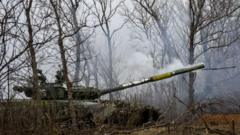In a significant diplomatic event that concluded in Anchorage, US President Donald Trump and Russian President Vladimir Putin wrapped up their meeting without reaching any agreement regarding a ceasefire in the ongoing conflict in Ukraine. Lasting nearly three hours, the summit ended with a joint statement but no formal questions were entertained, leading to widespread speculation about the outcomes.
North America correspondent Anthony Zurcher critiques Trump's performance, noting the president's ambiguous claims of “great progress” overshadowed by the absence of concrete results. “There's no deal until there's a deal,” Trump stated, a phrase that underlined the lack of agreements made during his time with Putin. Instead of asserting his touted role as a dealmaker, Trump left Alaska with ambiguity clouding his reputation, having failed to secure any firm commitments from his Russian counterpart.
The summit saw Trump sidelined during the press interaction as Putin dominated with lengthy remarks. While Trump commonly leads such engagements, he was left visibly subdued in the face of Putin's statements. This shift in dynamics may adversely affect Trump's standing both domestically and abroad, especially against a backdrop of previously exaggerated expectations of a productive meeting.
Questions loom over Trump's next steps, particularly whether he will impose the new sanctions he previously hinted at as repercussions for Russia’s refusal to agree to a ceasefire. His comments made in a post-meeting interview raised new uncertainties about his commitment to concrete action in the face of continuing conflict in Ukraine.
For the Russian side, Putin reveled in the international spotlight, presenting a stark contrast to Trump’s struggle to persuade him. Despite a red-carpet welcome from the US, the Russian president's refusal to commit to a ceasefire highlights the persistent chasm in perspective between the two leaders regarding the war.
Ukrainian officials expressed relief that no territorial concessions were reached but remain anxious about the sustained hostilities that could result from ongoing Russian aggression. Observers in Kyiv noted that without decisive action or agreements, the likelihood of escalated violence remains bleak, further complicating the already dangerous geopolitical landscape. These developments reaffirm the critical need for a viable path toward peace that appears elusive after the Alaska summit.



















